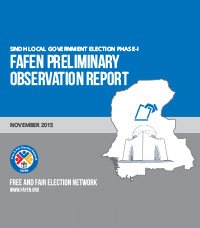Voters turned out in considerable numbers to vote for their local representatives during the first phase of election that was held in eight districts of Sindh on Saturday, October 31, 2015. Although relatively better organized, the local government elections were not free from procedural irregularities and tainted by the afternoon clash in Khairpur district that led to the killing of as many as 11 political workers. In addition, the incidents of restrictions on FAFEN observers for the observation of the voting process as well as counting of votes raised questions about the transparency of the process.
This preliminary report is aimed at indicating broad trends highlighted as a result of information that could be acquired on the Election Day from observers. A detailed report comprehensively covering the scale and scope of all observed irregularities during local government election would follow after the completion of all three phases. It is imperative to mention here that these are preliminary findings and they must not be generalized beyond their purview. At best, they are indicative of persistent electoral irregularities that are witnessed in all elections, reflecting ECP’s weak enforcement of election laws and its own devised Code of Conduct for Political Parties and Contesting Candidates. The foremost purpose of this initial report is to positively influence election management and improve conduct of second and third phases of local government election, scheduled to be held on November 19 and December 5, 2015 respectively.
A first look at FAFEN’s findings reveals that observers were barred from observation at 11 (8.2%) out of 134 polling stations and from observation of counting process at another seven (5.2%) polling stations from where the information could be acquired on Election Day. Additionally, there were seven (5.2%) polling stations which did not open at the scheduled official time and as many polling stations where secrecy of ballot was breached. There were nine (6.7%) polling stations where parties and candidates were seen canvassing inside the premises. There were five (3.7%) polling stations where polling was interrupted due to different reasons, while at four (2.9%) polling stations, voters complained against last minute change in their polling station. At another three (2.2%) polling stations, observers reported that the required election material was not available on time.
To download the preliminary report, click here


